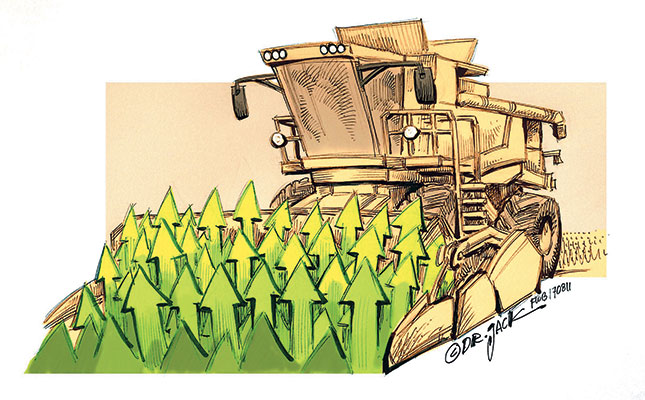
Photo: Dr Jack
The context for this year’s “Agricultural outlook 2017-2026” is record production and the abundant stocks of most commodities in 2016, which have kept prices well below the peaks experienced over the last decade.
Average prices of cereals, meats and dairy products continued to decline, while prices of oilseeds, vegetable oils, and sugar experienced a slight rebound in 2016.
Over the outlook period, demand for agricultural and fish commodities is projected to slow considerably.
READ the full report OECD-FAO Agricultural Outlook 2017-2026
The primary sources of growth in the last decade were: the People’s Republic of China, where rising meat and fish demand caused the consumption of animal feed to grow almost 6% every year; and the global biofuel sector, where the use of feedstock inputs grew almost 8% every year.
The replenishment of cereal stocks by 230 million tons over the last decade also augmented demand.
These recent drivers are not anticipated to support markets in the same way over the medium term, and no other sources to replace them are foreseen.
Slowdown in global food demand
Growth in food demand for virtually all commodities in the outlook is anticipated to be less than in the previous decade. Globally, per capita food demand for cereals is anticipated to be largely flat, with growth only expected in the world’s least developed countries.
Meat consumption prospects are seen as limited on the basis of recent trends in many countries, where dietary preferences, low incomes and supply-side constraints curb consumption growth.
Additional calories and protein are expected to come mainly from vegetable oil, sugar and dairy products.
Overall, ‘convergence’ towards western diets appears limited.
By 2026, calorie availability is projected to reach 2 450 calories per day, on average, in the least developed countries, and exceed 3 000 calories per day in other developing countries.
Still, food insecurity will remain a critical global concern, and the co-existence of malnutrition in all its forms poses new challenges in many countries.
The demand growth for ethanol and biodiesel has weakened due to lower fossil fuel prices and fewer incentives from government policies.
Even though energy prices are projected to increase, the derived demand for biofuel feedstocks, especially maize and sugar cane for ethanol, and vegetable oil for biodiesel, will grow slowly, except in key developing countries where demand increases are driven by more pro-active domestic policies.
Yield growth vs area growth
Future growth in crop production will be attained mostly by increasing yields. According to the outlook, 80% of additional food production will be achieved from improvements in yield, while the cultivation of additional land will account for only 20% of production growth.
Nevertheless, yield growth is projected to decrease slightly, but output will most likely be raised by closing large yield gaps that continue to persist, especially in sub-Saharan Africa.
The global area planted to cereal will only increase marginally, while a further expansion of the area planted to soya bean is projected to satisfy the demand for animal feed and vegetable oil.
Growth in meat and dairy production will be achieved from both larger herds and higher output per animal, with large differences in the intensity of production continuing to persist.
Growth in poultry production accounts for almost half of total meat production expansion over the decade, while milk production is expected to accelerate compared with the previous decade, most notably in India and Pakistan.
Aquaculture dominates growth in the fish sector, as capture-fish production is determined by the current level of stocks, and governed by policies to limit over-fishing.
China will maintain a share above 60% of global fish production; farmed fish production is the fastest growing protein source among the commodities in the outlook.
The growth in agriculture and fish trade is projected to slow to about half the previous decade’s growth rate.
However, trade will represent a broadly constant share of the sector’s output over the coming decade.
Trade outlook
Generally, agricultural trade has proven to be more resilient to macroeconomic fluctuations than trade in other goods. Given relatively high protection in the farming sector, agricultural trade could be boosted by further market liberalisation.
Food imports are becoming increasingly important for food security, particularly in sub-Saharan Africa, North Africa, and the Middle East. While for some countries this may reflect greater demand, but insufficient natural resources for growing food domestically, in other cases it may indicate agricultural development problems that need attention.
Net exports are projected to increase from the Americas, Eastern Europe and Central Asia, while net imports are expected to increase across other Asian and African countries.
Exports remain concentrated in a few supplying countries, contrasting with widely dispersed imports. This may imply a greater susceptibility of world markets to supply shocks, stemming from natural and policy factors, rather than demand shocks.
Under the outlook’s expected fundamental supply and demand conditions, real prices of most agricultural and fish commodities are anticipated to follow a slightly declining trend, keeping them below previous peaks over the next 10 years.
Prices of agricultural commodities are subject to considerable volatility, and may show large deviations from their long-term trends for an extended period of time.
The views expressed in our weekly opinion piece do not necessarily reflect those of Farmer’s Weekly.
For more information, email [email protected].











